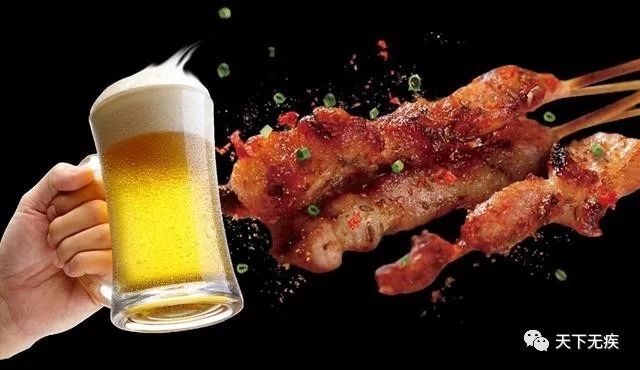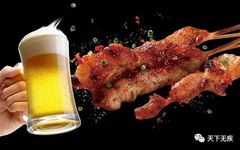 Phlegm and dampness are essentially two different types of pathogenic factors. Due to their close relationship, they often appear simultaneously, hence the term “phlegm-dampness” is commonly used. However, upon closer examination, it becomes evident that although both are phlegm-dampness, the pathways of their formation differ, leading to different treatment approaches. Generally speaking, the formation of phlegm-dampness is closely related to improper dietary habits. Specifically, it can be divided into two situations. One is excessive water intake, leading to the spread of dampness. For example, some tea enthusiasts may find their tea cups never leave their side during leisure time; or those who are convinced by the idea of drinking water, adhering to the rule of eight glasses a day without fail. Additionally, excessive beer consumption often produces similar effects. Upon pulse examination, a typical ru mai (slippery pulse) can often be observed, especially at the right guan (cun) position. These pervasive dampness pathogens cannot be effectively metabolized and expelled from the body. Over time, under the influence of various factors such as heat pathogens, cold pathogens, and qi stagnation, they gradually transform into phlegm. This is the pathway of dampness transforming into phlegm. The second situation, while also influenced by water and dampness factors, is more importantly related to the nature of the food consumed rather than the quantity of water. The most common example is overly greasy foods (such as braised eggplant or Dongpo pork), sticky foods (like tangyuan or zongzi), or excessively sweet foods (like cream or chocolate). These overly rich foods often signify a high concentration of animal and plant essences. It is important to note that these essences should be used sparingly to maximize their benefits. Excessive consumption leads to waste, affecting not only the essence itself but also our bodies. The essences that are not properly transformed are mostly retained in the body in the form of phlegm. These viscous pathogenic factors, which lie between solid and liquid, are most likely to obstruct yang qi, leading to heat generation and dampness formation. This is the pathway of phlegm generating dampness. Although the phlegm-dampness produced by these two pathways shares the same name, they are fundamentally different. For dampness transforming into phlegm, the key to treatment lies in promoting water metabolism; for phlegm generating dampness, the focus is on eliminating accumulation. Of course, both approaches involve basic methods such as Ban Xia (Pinellia) to dry dampness and transform phlegm. From the perspective of meridians, there are distinctions between the Taiyin and Yangming meridians.The Taiyin meridian governs transformation. When water and dampness are stagnant internally, it is crucial to restart the spleen’s function of transforming water, primarily involving the Foot Taiyin meridian. The acupoints Yin Ling Quan (Yinlingquan), Di Ji (Diji), and San Yin Jiao (Sanyinjiao), as well as Tai Bai (Taibai), are commonly used at this time. The Hand Taiyin’s Chi Ze (Chize) and Kong Zui (Kongzui) can also be used as complementary points. The Yangming meridian governs movement. When food accumulation is sticky and retained in the body, it is essential to promote its passage. The Foot Yangming meridian is rich in qi and blood, facilitating gastrointestinal movement. Acupuncture at San Li (Shangjuxu), Ju Xu (Juxu), and Feng Long (Fenglong) can accelerate the expulsion of accumulated matter. The Hand Yangming’s Shang San Li (Shangsanjiao) can also assist, not to mention He Gu (Hegu).
Phlegm and dampness are essentially two different types of pathogenic factors. Due to their close relationship, they often appear simultaneously, hence the term “phlegm-dampness” is commonly used. However, upon closer examination, it becomes evident that although both are phlegm-dampness, the pathways of their formation differ, leading to different treatment approaches. Generally speaking, the formation of phlegm-dampness is closely related to improper dietary habits. Specifically, it can be divided into two situations. One is excessive water intake, leading to the spread of dampness. For example, some tea enthusiasts may find their tea cups never leave their side during leisure time; or those who are convinced by the idea of drinking water, adhering to the rule of eight glasses a day without fail. Additionally, excessive beer consumption often produces similar effects. Upon pulse examination, a typical ru mai (slippery pulse) can often be observed, especially at the right guan (cun) position. These pervasive dampness pathogens cannot be effectively metabolized and expelled from the body. Over time, under the influence of various factors such as heat pathogens, cold pathogens, and qi stagnation, they gradually transform into phlegm. This is the pathway of dampness transforming into phlegm. The second situation, while also influenced by water and dampness factors, is more importantly related to the nature of the food consumed rather than the quantity of water. The most common example is overly greasy foods (such as braised eggplant or Dongpo pork), sticky foods (like tangyuan or zongzi), or excessively sweet foods (like cream or chocolate). These overly rich foods often signify a high concentration of animal and plant essences. It is important to note that these essences should be used sparingly to maximize their benefits. Excessive consumption leads to waste, affecting not only the essence itself but also our bodies. The essences that are not properly transformed are mostly retained in the body in the form of phlegm. These viscous pathogenic factors, which lie between solid and liquid, are most likely to obstruct yang qi, leading to heat generation and dampness formation. This is the pathway of phlegm generating dampness. Although the phlegm-dampness produced by these two pathways shares the same name, they are fundamentally different. For dampness transforming into phlegm, the key to treatment lies in promoting water metabolism; for phlegm generating dampness, the focus is on eliminating accumulation. Of course, both approaches involve basic methods such as Ban Xia (Pinellia) to dry dampness and transform phlegm. From the perspective of meridians, there are distinctions between the Taiyin and Yangming meridians.The Taiyin meridian governs transformation. When water and dampness are stagnant internally, it is crucial to restart the spleen’s function of transforming water, primarily involving the Foot Taiyin meridian. The acupoints Yin Ling Quan (Yinlingquan), Di Ji (Diji), and San Yin Jiao (Sanyinjiao), as well as Tai Bai (Taibai), are commonly used at this time. The Hand Taiyin’s Chi Ze (Chize) and Kong Zui (Kongzui) can also be used as complementary points. The Yangming meridian governs movement. When food accumulation is sticky and retained in the body, it is essential to promote its passage. The Foot Yangming meridian is rich in qi and blood, facilitating gastrointestinal movement. Acupuncture at San Li (Shangjuxu), Ju Xu (Juxu), and Feng Long (Fenglong) can accelerate the expulsion of accumulated matter. The Hand Yangming’s Shang San Li (Shangsanjiao) can also assist, not to mention He Gu (Hegu).
This article is selected from the “Growth Community for TCM Enthusiasts” organized by the Wuji Society. Long press to scan the QR code below for more details. Wuji Society, 2024-2025 Learning Theme: Advanced Acupuncture.
Selected Content from the Community1 Acupuncture, carving beauty through time 2 TCM teaches you how to rest efficiently 3 Daily maintenance of the spleen and stomach 4 Does room temperature water count as cold? 5 Allergies, how does TCM view them? 6 When hormones become medicine 7 From qi and blood to kidney essence 8 What happens when the stomach is strong but the spleen is weak? 9 Cherish kidney essence, do these three things well Long press to scan the QR code belowJoin the Growth Community for TCM Enthusiasts

